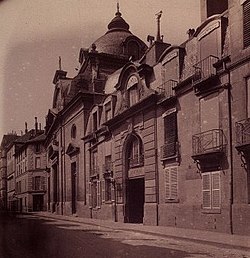Penthemont Abbey

The Pentemont Abbey is located in the 7th arrondissement in Paris , on the northwest corner of the intersection of Rue de Bellechasse (Nos. 37-39) and the Rue de Grenelle (Nos. 104-106). The abbey's former chapel has served as a reformed church since 1843.
history
The Penthement Abbey (also Pentemont , Panthemont and Pantemont ) was founded in 1217 by Philipp von Dreux , Bishop of Beauvais , near Beauvais . After the buildings were damaged by a flood in 1670, the abbey was relocated to Paris in 1672; the nuns were housed in the buildings of an Augustinian convent from the Congrégation du Verbe incarné (Congregation of the Incarnate Word), which was dissolved in 1670.
The monastery accepted young girls and older women from the upper classes. Louise-Adélaïde de Bourbon-Condé (1757-1824), daughter of Louis V. Joseph de Bourbon, prince de Condé and later the last abbess of Remiremont was brought up here, Joséphine de Beauharnais stayed here for some time during her separation from Alexandre de Beauharnais up. Louise d'Esparbès de Lussan, Comtesse de Polastron and future mistress of the Count of Artois lived here when she was 15 because, according to her family, she was too young to live with her 18-year-old husband.
At the beginning of the 18th century, the buildings taken over had become too old and too narrow. Marie-Catherine de Béthizy de Mézières, abbess since 1743, commissioned a completely new building for the convent. Several architects were approached: Jacques-François Blondel published a plan by François Franque (1710–1793) in the Encyclopédie ou Dictionnaire raisonné des sciences, des arts et des métiers , but the building was realized by Pierre Contant d'Ivry (1698–1777 ).
The foundation stone was laid in 1747, but the money was not enough, despite the support of Dauphin Louis and Cardinal Archbishop Armand II. François Auguste de Rohan-Soubise of Strasbourg, so that the work dragged on until the beginning of the revolution . The foundation stone for the chapel was laid in 1753 by the Dauphin. It was consecrated in 1756 and completed in 1766. After Contant's death in 1777, an architect named Petit took over the management. The convent buildings were finished in 1783. The final structure turned out to be much less splendid than what Contant had presented in his œuvres in 1769 .
In 1790 the abbey was dissolved, construction work was finished and the buildings became state property.
In 1803 the National Guard took over the monastery as barracks, later the Imperial Guard of Napoleon I and the Escadron of the Cent-gardes of Napoleon III. The chapel was cleared out, an intermediate floor installed and used as a storage room. In 1805 part of the monastery was demolished in order to build Rue de Bellechasse. In 1843 the chapel was given to the Reformed Church, while the rest of the building was left to the military. The War Ministry's pension fund moved in here in 1915, and from 1917 to 2015 the former monastery was the seat of the Ministère des Anciens combattants ( Ministry of War Veterans). Apart from a few decorative elements in the abbess's lodge, nothing has been preserved from the interior of the monastery.
List of the Abbesses of Penthemont
- 1219–1236: Agnès, first prioress
- 1236–1264: Marguerite I, first abbess
- 1264-12 ?? : Isabelle
- 12 ?? - 12 ?? : Ide
- 12 ?? - 1300: Marie I.
- 1300-1358: Marguerite II.
- 1358-1375: Marguerite III. de Vuault
- 1375-1415: Marguerite IV. De Rinceville
- 1415-1428: Henriette
- 1428–1441: Marthe Maquerelle
- 1441-1479: Nicole
- 1479–1496: Marguerite V.
- 1496–1516: Anne I. du Castel
- 1516-1521: Marguerite VI. Trisel
- 1521–1530: Anne II.
- 1530–1552: Huguette de Creilly
- 1552–1562: Françoise I. Ogier de Berry
- 1562–1567: Françoise II. De Fontaines
- 1567–1568: Catherine I. Loisel de Flanbermont
- 1568–1586: Marguerite VII. Loisel de Flanbermont
- 1586–1623: Catherine II. De Guiverlay
- 1623-1633: Charlotte I. de Cavoye
- 1633-1641: Jeanne I. Thierry
- 1641–1644: Jeanne II. Ogier de Berry
- 1644-1667: Françoise III. Le Charon
- 1667–1715: Hélène de Costentin de Tourville
- 1715–1719: Charlotte II. De Colbert-Croissy ( Colbert House )
- 1719–1743: Marie II. Anne-Bénigne-Constance-Julie de Rohan-Guéménée ( Rohan House )
- 1743-1790: Marie III. Catherine de Béthisy de Mézières
literature
- Calendrier historique et chronologique de l'Église de Paris, par AM Le Fèvre prêtre de Paris et bachelier en théologie, 1747.
- Jean-Marie Pérouse de Montclos (ed.): Le guide du patrimoine. Paris. Hachette, Paris 1994.
- François Rousseau: Histoire de l'Abbaye de Pentemont, depuis sa translation à Paris jusqu'à la Révolution. In: Mémoires de la société de l'histoire de Paris et de l'Île-de-France. Volume XLV, 1918, p. 171.
Coordinates: 48 ° 51 ′ 23 ″ N , 2 ° 19 ′ 19 ″ E
